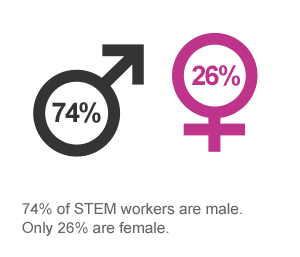|
By Michelle Muzzio, Chemistry PhD Student
 The Trump administration cited a correct fact that women make only 25% of the STEM workforce. However, this figure varies across scientific disciplines. For example, women make up much closer to 50% of the work force in the life sciences and specifically, the EPA (one of the agencies cut by the Trump administration). The Trump administration cited a correct fact that women make only 25% of the STEM workforce. However, this figure varies across scientific disciplines. For example, women make up much closer to 50% of the work force in the life sciences and specifically, the EPA (one of the agencies cut by the Trump administration). The bills, one focusing on NASA and the other on the National Science Foundation (NSF), aim to address the problem that only 1 in 4 women with degrees in STEM fields actually work in a STEM-intensive occupation. Of particular interest is that the NSF-focused bill, Promoting Women in Entrepreneurship Act, promotes entrepreneurship of women to move beyond the lab and bring their science to the commercial world. So what do we do with this information that goes against public perception? There are plenty of theories about what this could mean. Some are arguing that it was an effort for the administration to seem like it was fighting for women in science. In reality, the NSF-focused bill is only the addition of one line of legislation on the already existing Science and Engineering Equal Opportunities Act that has been around since 1980 in the Carter administration. Further, a primary advisor in the Trump administration, Steve Bannon, was one of the founders of Breitbart News, the news agency that published a disgusting and disheartening article two years ago suggesting there should be a cap of women in science because women simply can't cut it in "highly competitive environments." Some, however, are arguing that the Trump administration is taking a genuine interest in science policy, particularly the need to increase the amount of women in science. While many of Trump's recently signed bills have garnered national and international interest, these two bills have not been as nearly discussed and certainly have not trended. Considering science policy is not nearly talked about enough in the realm of politics, every opportunity should be taken to "run with it," for lack of a better expression, when anyone in politics begins a discussion. Why then, was the administration's attempts so futile and taken with almost a laugh from scientists? The answer, most simply, is the administration's slashing of the budgets of the Environmental Protection Agency (EPA) and the National Institute of Health (NIH). While many articles have attacked this issue from a research perspective (of course, we could be losing valuable strides made in cancer biology, climate change, and every in between), it is also an issue that needs to be addressed from women in STEM. The human resources department of the EPA depicts that since 2011, women have made up half of their work force. This is, of course, above the 25% figure that the Trump Administration cited as the national average. Conscious effort has caused this increase, and actually, aforementioned Dresselhaus was involved with this movement. The NIH, particularly, will be cut by over 18%. Ignoring for a moment, the incredible research that can be lost with that 18%, we also have to consider that the life sciences (the main constituents of the NIH) are the only branch of science, right now, that is almost 50-50 in the ratio of women to men employed in these fields. Actually, women outnumber men as degree holders in the life sciences. In the end, while saying, "Women in science are important," is nice in design, cutting funding from organizations that are making a conscious effort to offer opportunities to women is terrible in application. It is time for the Trump administration to put its money where its mouth is when it comes to women in STEM.
0 Comments
Leave a Reply. |

